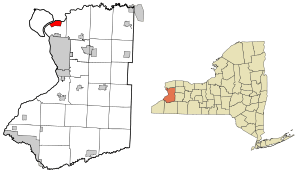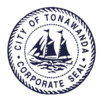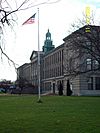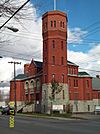Tonawanda, New York facts for kids
Quick facts for kids
Tonawanda
Tahnawáteh (Tuscarora)
|
||
|---|---|---|

The North Tonawanda side of the Gateway Harbor
|
||
|
||

Location of Tonawanda in Erie County and New York
|
||
| Country | ||
| State | ||
| County | Erie | |
| Government | ||
| • Type | Mayor-Council | |
| Area | ||
| • Total | 4.09 sq mi (10.60 km2) | |
| • Land | 3.80 sq mi (9.85 km2) | |
| • Water | 0.29 sq mi (0.75 km2) | |
| Elevation | 571 ft (174 m) | |
| Population
(2020)
|
||
| • Total | 15,129 | |
| • Density | 3,978.18/sq mi (1,535.87/km2) | |
| Time zone | UTC−5 (EST) | |
| • Summer (DST) | UTC−4 (EDT) | |
| ZIP code |
14150
|
|
| Area code(s) | 716 | |
| FIPS code | 36-74166 | |
| GNIS feature ID | 0979550 | |
Tonawanda is a city located in Erie County, New York, in the United States. In 2020, about 15,129 people lived there. It sits on the northern edge of Erie County, right across the Erie Canal from North Tonawanda. It's also near Grand Island and Buffalo, and is part of the larger Buffalo-Niagara Falls metropolitan area.
Contents
History of Tonawanda
The name "Tonawanda" comes from the Tuscarora word Tahnawá•teh. This word means "confluent stream," which describes where two streams or rivers flow together.
Early Settlement and Growth
White settlers began arriving in Tonawanda after the Revolutionary War. Henry Anguish built the first log home here in 1808. He later opened a tavern in 1811. Both buildings were on the south side of Tonawanda Creek, where it meets the Niagara River.
The area grew slowly until the Erie Canal opened in 1825. The canal was built right into the creek itself. The Town of Tonawanda was officially formed in 1836. The Erie Canal and new railroads brought many jobs and helped the economy grow. By the late 1800s, both sides of the canal were busy with businesses. Tonawanda became a major center for processing lumber.
In the mid-1800s, the main business area of Tonawanda became a village. This village tried to join with North Tonawanda, which was across the canal. But this plan didn't work out. So, in 1904, the village of Tonawanda became its own city.
The 1898 Tornado
On September 26, 1898, a tornado hit the City of Tonawanda. It crossed the river from Grand Island. The tornado damaged the old Murray School and many homes on Franklin and Kohler streets. The worst damage was on Fuller Avenue, where several homes were destroyed. Luckily, no one died, but many people were hurt.
Goose Island's Transformation
From the mid-1800s to the early 1900s, a part of Tonawanda was called Goose Island. This was a man-made island in the Niagara River, created by the Erie Canal. Goose Island was shaped like a triangle, with the Niagara River on one side, Tonawanda Creek on another, and the Erie Canal on the third.
It was famous among sailors as the end point of the Erie Canal. Many canal workers would stay on Goose Island during the winter. It was known as a rough part of town with many cheap hotels and bars.
Over time, things changed. The lumber business in Tonawanda slowed down. A boxboard mill was built on the island. The canal also became motorized, so fewer canal workers were needed. In 1918, the part of the canal from Tonawanda to Buffalo was closed and filled in. This meant Goose Island was no longer an island.
By the 1920s and 1930s, many of the old businesses on Goose Island closed. More land was used for the boxboard mill. In the 1970s, the mill closed and was torn down. Many old Goose Island streets disappeared. Today, new homes have been built along the Niagara River, making the area much nicer.
Spaulding Fibre Company
Spaulding Fibre was a big company that made materials like leatherboard and vulcanized fibre. They also made bakelite, which they called Spauldite. The company operated in Tonawanda from 1911 to 1992 and was the city's largest employer.
The company started in 1873 in Massachusetts. Jonas Spaulding and his brothers ran the business. Jonas's three sons later joined him. They opened more mills in New Hampshire.
In 1911, the Spaulding brothers decided to open a new plant in Tonawanda, New York. The mayor of Tonawanda, Charles Zuckmaier, had asked them to come. The new plant cost $600,000 to build. It opened on April 1, 1912, with 40 employees.
Around 1924, the company changed its name to Spaulding Fibre Company. In the 1930s, they started making Spauldite at the Tonawanda plant. This material was similar to Bakelite.
After the last of the three brothers, Huntley Spaulding, passed away in 1955, the company became part of a special trust. In 1956, the Tonawanda plant expanded, doubling its size. The company's main offices also moved to Tonawanda. In the 1960s, they added a third product line: Filawound tubing.
In 1961, the Tonawanda plant celebrated its 50th anniversary. It covered a huge area of 610,000 square feet (56,670 square meters). It employed 1,500 workers and was the biggest taxpayer in Tonawanda.
In 1966, the company was sold to Monogram Industries. The Tonawanda plant slowly began to decline. It was sold again in 1984 to Nortek. In 1988, the company name changed to Spaulding Composites. The Tonawanda plant finally closed on August 24, 1992. By then, only 300 people worked there.
The old plant site was very large, covering 860,000 square feet (79,897 square meters). It became a "brownfield" site because of industrial waste. In 2006, the old buildings were torn down. The tall smoke stack, which was 250 feet (76 meters) high, was also taken down. The cleanup of the site finished in August 2010.
Historic Places to Visit
Several places in Tonawanda are so important that they are listed on the National Register of Historic Places. These sites help us remember the city's past:
Geography of Tonawanda
Tonawanda is located at 43°0′40″N 78°52′38″W / 43.01111°N 78.87722°W.
The city covers an area of about 4.1 square miles (10.6 square kilometers). Most of this is land, about 3.8 square miles (9.8 square kilometers). The rest, about 0.3 square miles (0.75 square kilometers), is water.
Neighboring Areas
Tonawanda is surrounded by other cities and towns:
- To the north, across the Niagara County line, is the City of North Tonawanda.
- To the west, south, and east is the Town of Tonawanda.
- To the northwest, across the Niagara River, is the Town of Grand Island.
Local Neighborhoods and Spots
- Gastown – This neighborhood is in the northeast part of Tonawanda, next to the Erie Canal. It got its name from the Gas Light Co. that used to be there.
- "The Hill" (also called "Riverview") – This area is around Tonawanda High School. It's called "The Hill" because it's a bit higher than the rest of the city. It's also known as Clay Hill because of the clay deposits there.
- Millstream – A neighborhood on the city's eastern side. It's named after a stream that used to flow through the area, but it's mostly underground now.
- Ives – A popular spot in the middle of Tonawanda with a skatepark, ice hockey rink, soccer field, and tennis courts.
- Delawanda – An older neighborhood located north of Canton Street and east of Delaware Street.
Many residents call the City of Tonawanda the "C.O.T." This helps them tell it apart from the "Town" of Tonawanda.
Main Roads and Highways
Several important roads run through Tonawanda:
 New York State Route 265 (Main St., Seymour St., River Rd.) – This road goes north and south through the city. It crosses the Erie Canal into North Tonawanda.
New York State Route 265 (Main St., Seymour St., River Rd.) – This road goes north and south through the city. It crosses the Erie Canal into North Tonawanda. New York State Route 266 (Niagara St.) – This road goes east and west, running next to the Niagara River.
New York State Route 266 (Niagara St.) – This road goes east and west, running next to the Niagara River. New York State Route 384 (Delaware St.) – This road also goes north and south through the city.
New York State Route 384 (Delaware St.) – This road also goes north and south through the city. New York State Route 425 (Twin Cities Memorial Highway) – A major highway in the eastern part of town. It's important for travel between Tonawanda and North Tonawanda.
New York State Route 425 (Twin Cities Memorial Highway) – A major highway in the eastern part of town. It's important for travel between Tonawanda and North Tonawanda.
Culture and Fun in Tonawanda
Canal Fest Celebration
Every year, the City of Tonawanda teams up with North Tonawanda to celebrate the Canal Fest of the Tonawandas. For one week, both communities celebrate their history along the western end of the Erie Canal. It's the biggest festival of its kind!
The festival started in 1983. Its goal was to help local businesses, raise money for non-profit groups, and offer fun activities for everyone. The first Canal Fest was held on both sides of the canal.
Today, a non-profit group organizes the Canal Fest. More than 150,000 people are estimated to attend each year. It's free to enter, so it's hard to get an exact count. The Canal Fest is the largest event along the Erie Canal and one of the biggest in New York State. In 2020, the festival was canceled for the first time due to the Coronavirus Pandemic.
Gateway Harbor Park
Tonawanda also shares Gateway Harbor with North Tonawanda. This is a public park along the Erie Canal, just before it meets the Niagara River. In the summer, boaters can dock their boats here for free. The park is very popular during free concerts organized by the local chamber of commerce. Many local businesses help sponsor these concerts on both sides of the park.
Local Landmarks to Explore
- The Historical Society of the Tonawandas runs a museum in the old New York Central & Hudson Valley Railroad station. It has exhibits about the area's lumber industry and Erie Canal history.
- The Long Homestead is a restored house from 1829. It shows what homes looked like in the early 1800s. The Historical Society offers guided tours.
- Isle View Park is on the Niagara River and looks out over Grand Island. You can bike, hike, rollerblade, fish, and launch boats here. The Riverwalk trail goes through the park, and a bridge connects it to Niawanda Park.
Tonawanda's NFL Team
Tonawanda was once home to the Tonawanda Kardex Lumbermen. This was a professional football team that played between 1916 and 1921. They are best known for playing one game in the National Football League.
Population Information
| Historical population | |||
|---|---|---|---|
| Census | Pop. | %± | |
| 1870 | 2,812 | — | |
| 1880 | 3,864 | 37.4% | |
| 1890 | 7,145 | 84.9% | |
| 1900 | 7,421 | 3.9% | |
| 1910 | 8,290 | 11.7% | |
| 1920 | 10,068 | 21.4% | |
| 1930 | 12,681 | 26.0% | |
| 1940 | 13,008 | 2.6% | |
| 1950 | 14,617 | 12.4% | |
| 1960 | 21,561 | 47.5% | |
| 1970 | 21,898 | 1.6% | |
| 1980 | 18,693 | −14.6% | |
| 1990 | 17,284 | −7.5% | |
| 2000 | 16,136 | −6.6% | |
| 2010 | 15,130 | −6.2% | |
| 2020 | 15,129 | 0.0% | |
| U.S. Decennial Census | |||
In 2000, there were 16,136 people living in Tonawanda. There were 6,741 households and 4,361 families. The population density was about 4,253 people per square mile (1,642 people per square kilometer).
Most of the people living in the city were White (98.08%). A small percentage were Black (0.42%), Native American (0.46%), or Asian (0.39%). About 0.89% of the population was Hispanic or Latino.
About 28.9% of households had children under 18. Nearly half (49.9%) were married couples. The average household had 2.39 people, and the average family had 3.01 people.
The median age in the city was 39 years old. About 23.9% of the population was under 18. About 16.8% were 65 years or older.
Famous People from Tonawanda
Many notable people have connections to Tonawanda, including:
- Ockie Anderson, a former NFL player
- Fred Brumm, an NFL player
- Rick Cassata, a retired CFL quarterback who went to Tonawanda High School
- Glen Cook, a retired Texas Rangers pitcher who also attended Tonawanda High School
- Jane Corwin, a New York State Assemblywoman
- Darren Fenn, owner of the Buffalo eXtreme
- Dave Geisel, a retired MLB player who attended Tonawanda High School
- Gregory John Hartmayer, the Bishop of Savannah
- Frank Hinkey, a member of the College Football Hall of Fame
- Chris Lee, a former U.S. Congressman
- Bert Lewis, a former MLB pitcher
- Joe Mesi, a retired boxer
- Blake Miller, a former college football head coach
- Warren H. Muck, a member of the famous Easy Company from World War II
- John Neumann, the first American bishop to become a saint
- Niland brothers, notable soldiers from World War II
- Marc Panepinto, a New York State Senator
- Thomas Perry, an author
- Bobby Shuttleworth, an MLS goalkeeper
- John Simson Woolson, a former Federal judge
- Jules Yakapovich, a longtime football coach at Kenmore West High School
See also
 In Spanish: Tonawanda para niños
In Spanish: Tonawanda para niños







